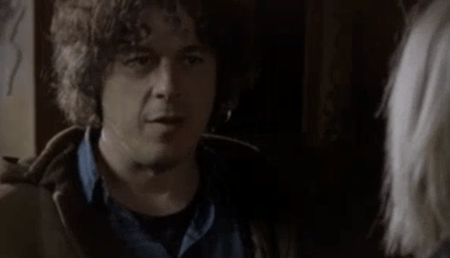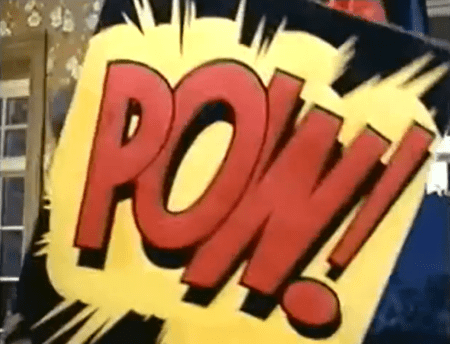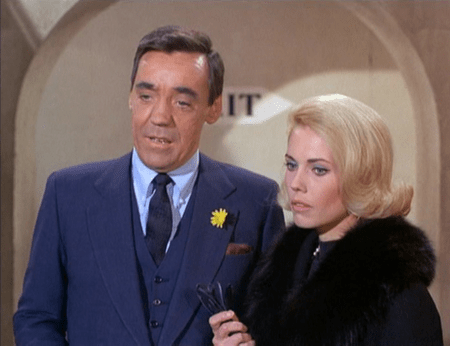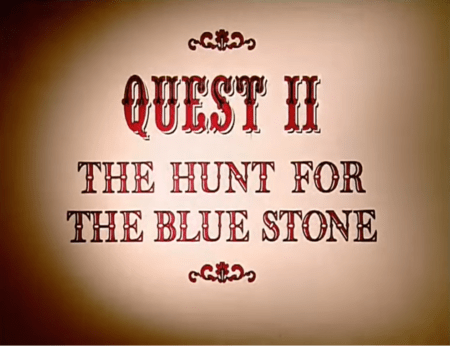Here you are. Here’s a cracker. One for the teenagers [1]:
This is from The Grinning Man, the New Year 2009 special episode of the comedy-mystery series Jonathan Creek (1997-2016) and it shows the eponymous magic/crime consultant meeting the character who will become his new colleague for his next few cases. And her name is Joey Ross.
And when Jonathan responded to Joey’s name in the above manner, my wife and I punched the air in joy at a wonderful gag that we suspected only about a dozen other people in the country were getting that evening. It felt like it was a gag just made for us.
On the US service sitcom The Phil Silvers Show (aka You’ll Never Get Rich: 1955-1959), following the sudden death of actor Harry Clark on 28 February 1956, the character of Mess Sergeant Stanley Sowici was replaced in the show’s second year by Mess Sergeant Rupert Ritzik, a perpetually unlucky persona played by blue-language burlesque comedian Joe E Ross. He later starred as Patrolman Gunther Toody of New York’s 53rd Precinct in the police sitcom Car 54, Where Are You? (1961-1963)… while for another generation he is probably best known for his distinctive vocal delivery on Hanna-Barbera animations such as Help!… It’s the Hair Bear Bunch! (1971-1972) and Hong Kong Phooey (1974). You’d most likely recognise his voice if you were of a certain age… but, by 2009, some 28 years after his death, it’s unlikely that most of the BBC One audience would recall his name.
But when Jonathan linked Joe E Ross with Joey Ross and thus fused two of our favourite television shows, we were immensely happy.
Of course, by 2009, my wife and I had generally come to expect this level of referencing from David Renwick, the writer and creator of Jonathan Creek. We had both been devotees of his dark sitcom One Foot in the Grave (1990-2000) which had previously deployed with amazing precision his clear love and knowledge of archaic television in the sharp, pointed dialogue from Victor and Margaret Meldrew.
“Ever since [Victor] bought this seafood cookery book, every mealtime has been like The Quatermass Experiment (1953),” exclaimed an exasperated Margaret in Hole in the Sky. She didn’t lazily say “like something out of Quatermass” in a vague reference to Nigel Kneale’s BBC tv science-fiction thrillers of the 1950s (and their Hammer big-screen remakes)… no, she made specific reference to the creature seen at the climax of the original serial (although, naturally, without specifying the year of transmission in brackets… she only does that in the version that was subtitled for academics).
“You will end up tonight freezing to death on a demolition site dressed as the Cisco Kid,” fumes an even more exasperated sombrero-sporting Victor in In Luton Airport No One Can Here You Scream, comparing himself to the heroic Mexican caballero who was the title star of television’s first colour series (1950-1956), a Western barely seen on UK terrestrial television since 1961.
A particularly random comment from Victor’s wandering mind as he struggled to fall asleep in Timeless Time was “Mike Hope and Albie Keen. Never did hear any more about them.” Even if BBC1 viewers of 1990 couldn’t recall the sub-Morecambe and Wise double-act of two decades earlier, certain segments of the audience would recall the duo from either their eponymous ATV series (1965-1966) or their later junior offerings of Hope and Keen’s Crazy House (1970-1971), it’s spin-off Hope and Keen’s Crazy Bus (1972) and finally The Hope and Keen Scene (1974-1975)
These references endeared David’s writing to us even more because it reminded us that here was a writer who remembered and understood many of the same elements of televisual history as we did… and did so with a scientific accuracy that had previously been one of the delights in the sketch show End of Part One (1979-1980) which – as we’ve seen before – took great delight in exposing the mechanics and short-comings of popular television of the day.
And we do like it when we find a medium that we adore showing its awareness of other shows from our favourite schedules. At the end of The Winged Avenger, an episode of the off-beat thriller series The Avengers (1961-1969), Steed defeats a murderous comic book artist who is committing acts of vengeance while dressed as his picture strip character… and does so by striking the miscreants with boards bearing words such as…
… and we cheer because we know that the visuals and the music are adopting the style of Batman (1966-1968).
Now, as a chronolog [2], I get curious, and I need to dissemble these things to nail the time sequence. In a later episode, The Morning After, Steed has been watching television. Turning off his set, he says to himself: “Sock it to me.” This was the catchphrase of Judy Carne’s from the American comedy show Rowan & Martin’s Laugh-in (1968-1973), launched by NBC in the US on 22 January 1968, discussed in the British press by June 1968, and debuting for UK audiences via BBC2 on 8 September 1968… Now, Laugh-in retained its Monday 8pm slot for the Fall 1968 season from 16 September, exactly one week before The Avengers returned to ABC at 7.30pm. Originally, in March, it had been planned that Laugh-in would move to 10pm on Fridays with The Avengers on Mondays, but by May, NBC had relented… and the overlap was on. Thus, with his own caper concluded by around 8.25pm, Steed would be able to watch Judy on the competing channel. According to Michael Richardson’s indispensable work Bowler Hats and Kinky Boots (Telos: 2014), this scene was filmed on 31 October 1968 – a few weeks into the Fall season; it first appeared in the UK on 10 January 1969 and was networked by ABC on 27 January 1969… with ABC announcing its cancellation of The Avengers between these two dates, largely because Judy, Dan, Dick and their friends had been socking it to Steed…
And in the series Honey West (1965-1966), the episode Come to Me, My Litigation Baby aired on 18 February 1966, concluding with a tag scene in which the new dance craze the ‘Honey West Walk’ is unveiled to the world. This is screamingly inspired by the ‘Batusi’ as danced by Batman and Molly (the Riddler’s cohort) in Hi Diddle Riddle, the debut episode of Batman that had aired on 12 January 1966. So, how quick were they off the mark with this? Well, looking at the trade magazines, it would very much seem that the Honey West episode was shot about a week after the launch of Batman. How brilliantly quick is that?
And there’s Maxwell Smart and Agent 99 coming up against KAOS agents Donald Snead and Mrs Emily Neal in Run, Robot, Run, an edition of the espionage caper Get Smart (1965-1970) screened on 16 March 1968 and filmed at the end of December 1967, shortly before the return to John Steed and Mrs Emma Peel in The Avengers to the US networks in January 1968. How sweet is that?
But… what we admire even more is when a series like The Avengers is referenced not in a contemporary show, but decades after the event. For example, from October to December 2002, Blue Peter (1958-) featured a serialised adventure called Quest II: The Hunt for the Blue Stone. Each instalment opened with an introduction to Miss Singleton’s operatives – Loveday Beck, William Lord Landis and Jack Dodge – with a narration that explained how “Extraordinary crimes must be solved by agents extraordinary.” Now I’d imagine that the target audience wasn’t sat there saying “Goodness! How wonderful! Somebody riffing on the narration of the special introductory film sequence shot for the broadcasts of The Avengers on the ABC network from March 1966 – and thus not even screened in the UK! – which announced that ‘Extraordinary crimes against the people and the state have to be avenged by agents extraordinary’.” But the editor of these shows was Richard Marson, and we’ve already established how much Richard loves and admires the history of television via articles in PrimeTime and his superb book Inside UpDown (Kaleidoscope: 2011). [3]
Indeed, within the last few months, my wife and I were overjoyed by the exploits of Rodney Hooper and Linda Lang in Operation QT (196X), as depicted in the Lights, Camera, Murder! episode of Sister Boniface Mysteries (2022). But that’s another story…
Or the cast of Moonlighting (1985-1989) slipping into the personas of comedy characters from earlier epochs as they feature in The Bluemooners, a framing device for the episode A Trip to the Moon that apes the look of the classic filmed run of The Honeymooners (1955-1956). According to producer Jay Daniel in Scott Ryan’s amazing book Moonlighting: An Oral History (Fayetteville Mafia Press: 2021), this was filmed on 20 April 1987… over three decades after production at the Adelphi Theatre in New York had concluded at the end of March 1956. And the team clearly really respected their ancestor. “We used multiple cameras so that it looked like The Honeymooners,” recalled Jay of these superbly made sequences.
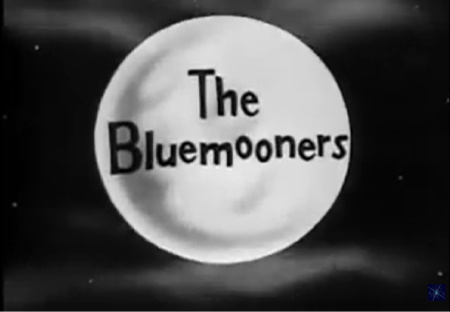
Fig. 5: Sorry, not doing obvious Honeymooners catchphrases as they’re a bit controversial these days …
Now, previously, we’ve considered that specific cultural references to television can be a very bad thing. Some of you may remember an oblique reference to Sapphire & Steel (1979-1982) that ‘locked out’ my dear friend and writing colleague Emily Cook from a fun conversation a few years back. Well, you know, since then, Emily has entered the industry and is actually making television. She’s a development executive on Apple TV+’s Constellation (2022-) coming to a platform near you soon. So, as it turned out, maybe cultural references aren’t as evil as we thought. She’s the one with a glowing creative career ahead of her, and I’m the one writing this blog. Go Emily!
And what of the creative work that doesn’t just use these references to shows of yesteryear in the manner of bonus easter eggs for the televisually gifted, but actually uses them as a major part of the format and even comments on our usage of them? This triumphant approach was adopted recently not on television, but in the sound medium of radio via Damned Andrew (2022-), a gorgeously strange and captivatingly imaginative sitcom broadcast by BBC Radio 4.
Narrated by Alan Moore [4], the narrative unfolds in a world where London (and parts of Leeds) have spent twelve months partly inhabited by noetic spirit entities (the term “demons” is sometimes taken to be offensive) as a result of the Great Incursion – since when humanity co-exists with unidentifiable creatures and everyone now dreams in HD. The cause of the Incursion was the fact that non-binary metalhead Andrew O’Neill read the first edition of a grimoire, The Anathema of Zos, aloud, thus opening a portal to an occult realm behind the sofa in their living room.
Already enjoying the outlandish fantasy element, my wife and I were then amazed when a magical shaman made reference to Dusty Bin, the mascot of Yorkshire’s quiz/entertainment show 3-2-1 (1978-1988). A reference that’s pretty obscure for a mainstream audience.
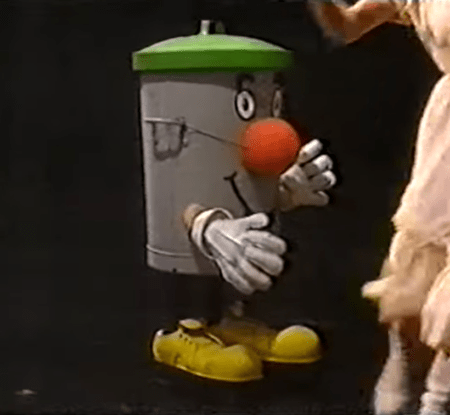
Fig. 6: “Ruined remains my contents are/I am a dustbin, not a car” [5]
The dialogue was then peppered with references to The Tube (1982-1987), commercials for Um Bomgo, phrases such as “You can’t get better than a Kwik Fit fitter” and chants of “There’s somebody at the door, there’s somebody at the door”. Then, when Andrew reports for their shift delivering pizzas at the despatch office for Deliveraa-ee-ii-oo-uu, they are confronted by a new, aggressive Cockney supervisor:
SUPERVISOR: New broom darlin’!
ANDREW: Are you Beryl Reid?
SUPERVISOR: Oh, turn it up! Mike Reid!
ANDREW: So, why do you look like Beryl Reid?
SUPERVISOR: Don’t ask me you slag! Some mutant’s revivin’ all the old comedians. Me an’ Beryl seem to have got mixed up. Tell you what – my dreams are weird!
ANDREW: Well, I loved you in Earthshock… and Dimensions in Time.
As with Joe E Ross/Joey Ross, we laughed. We don’t know how many other people did, but we did. Because this one takes some unpacking. It’s based around Doctor Who (MCMLXIII-), and you need to know that comedy actress Beryl Reid played a spaceship captain in the 1982 serial Earthshock and that comedy actor Mike Reid made a cameo as Frank Butcher in Dimensions in Time, a 3D crossover between Doctor Who and the soap opera EastEnders (1985-) that aired as part of the Children in Need telethon in 1993. After the above dialogue, there’s no explanation – not even any mention of the words Doctor and Who in that order. Just the reference.
Now, we’ve considered previously how continually returning to items from our formative years is composed of pros and cons that have to be very carefully navigated in order to ensure that a revisit gives us what we need or want in the correct manner at the right time and the right price. Well, Damned Andrew did that better even than that blog that you may or may not have just clicked on. In the final instalment – ███████ WARNING! – Andrew has to enter the portal to stop the fabric of the universe unravelling. They first enter a series of defunct music venues that form a labyrinth of lost sub-culture. “This is about nostalgia,” they soon ruminate before being attacked by what they describe as “that troll doll thing from Terror of the Autons only massive” [6]. “The Past consumes,” declared Andrew, “I’m being attacked by nostalgia!” In fact, the sentient portal has created a trans-dimensional gateway specially from Andrew’s memories as a bit of fun for them, while warning: “Turns out living in the past is quite dangerous.” Andrew makes a final attempt to fight nostalgia with more nostalgia (“Io evohe Azal! Eko eko Azal! Cailleach!”) before realising – with some degree of resignation – “You have to live in the now.”
So, yes, we accept that we have to live in the now… but the now is often enlivened by the unexpected glimpse of nice bits of the past. Because they demonstrate understanding and affection. Talking recently to my friend Dr Victoria Byard, I was reminded again what a vital part of engaging with television’s history is in shaping its future.
So, again, yes, references! Bring ’em on! If you people who are out there currently making television demonstrate – just now and then – to us that you love the history of television as much as we do, then we may well love your own new show that little bit more than we already do.
And when, in Oliver’s Travels (1994), Baron Kite dials Baxter, the security consultant of Cosmos Security PLC, his tone phone keypad plays the signature tune to Z Cars (1962-1978). Of course it does. It’s all about paying homage…
Andrew Pixley is a retired data developer. For the last 30 years he’s written about almost anything to do with television if people will pay him – and occasionally when they won’t. Right, sorry to nag, but you did write to, phone or e-mail the BBC about the removal of key channels from Freeview over the summer didn’t you? It’s really rather important. It’s all very well you sitting in your campus offices analysing and writing about television, but you also need to make sure that as wide a range of material is available to all audiences as possible, and there’s sectors of the audience that will be marginalised as a result of these proposed changes. The people at the other end of 03700 100 222 and YourQuestions@bbc.co.uk are really nice. They never take these things personally, and some of them are just as concerned as you are. So, y’know, spare a moment or so for that polite letter, call or electronic dispatch to make sure that things like the amazing reinvention of The Demon Headmaster (2019) by Emma Reeves (which, itself, references back to The Demon Headmaster (1996-1998)) and repeats of The Roads to Freedom (1970) remain available to as many people as possible…
Footnotes
[1] Now, if you know that what Tony Hancock said next on his Royal Festival Hall show screened on BBC2 on 15 October 1966 was “George Arliss. What do you mean never heard of him? He’s only been dead forty years”, then you’ve probably already twigged what this blog is about, and it’s most likely that you really don’t need to go any further with it. What’s more, if you know that Chico’s answer to Groucho’s question that forms the title to this piece is “Aw, that’s awright. You don’t need no references. I like your face” and that it comes from the opening episode of the radio comedy Beagle, Shyster and Beagle (1932), then I’m delighted to inform you that you don’t need to read this blog at all. That’s the kind of service we like to offer you here at CSTonline – the sort of consideration that you wouldn’t find on other academic blogs. Now you have extra time to nip out to the Co-op and buy those croissants that you’ve been saving up for.
[2] Yes, it is a word, and you can use it in Scrabble® and everything.
[3] In fact, Quest II, set in Victorian times, also featured actor Gerald Harper who – ███████ ALERT! – was revealed to be the masked villain ‘The Visage’, much like The Face, the masked villain faced regularly by Edwardian adventurer Adam Adamant as played by Gerald Harper in Adam Adamant Lives! (1966-1967). Yes, Gerald Harper appearing in Blue Peter! And the earlier serial The Quest had featured Jean Marsh! Yes, that Jean Marsh from Upstairs Downstairs (1971-1975).
[4] Yes, that Alan Moore.
[5] … and we’re back to David Renwick, here working alongside his long-time collaborator Andrew Marshall on the former radio show The Burkiss Way (1976-1980), more specifically the edition Remember the Burkiss Way. So, what is the prize hidden behind the clue left by an out-of-work actor whom nobody recognised. Over to you Ted: “The rhyme said: ‘I am a dustbin not a car’. Well, what’s a dustbin not a car? Obviously a dustbin… but, nah, that would have been too easy. The clue lay in the first bit: ‘Ruined remains’. ‘Ruin’ meaning obviously it was an anagram and anagram of ‘I am a dustbin, not a car’ is of course ‘I am a car, not a dustbin’. Yes, you’ve rejected it – our star prize of a brand-new Austin Morris Cooper.”
[6] Just to let you know that if you want to get all these remaining references, you’re now on your own. It’s what Google’s for.


